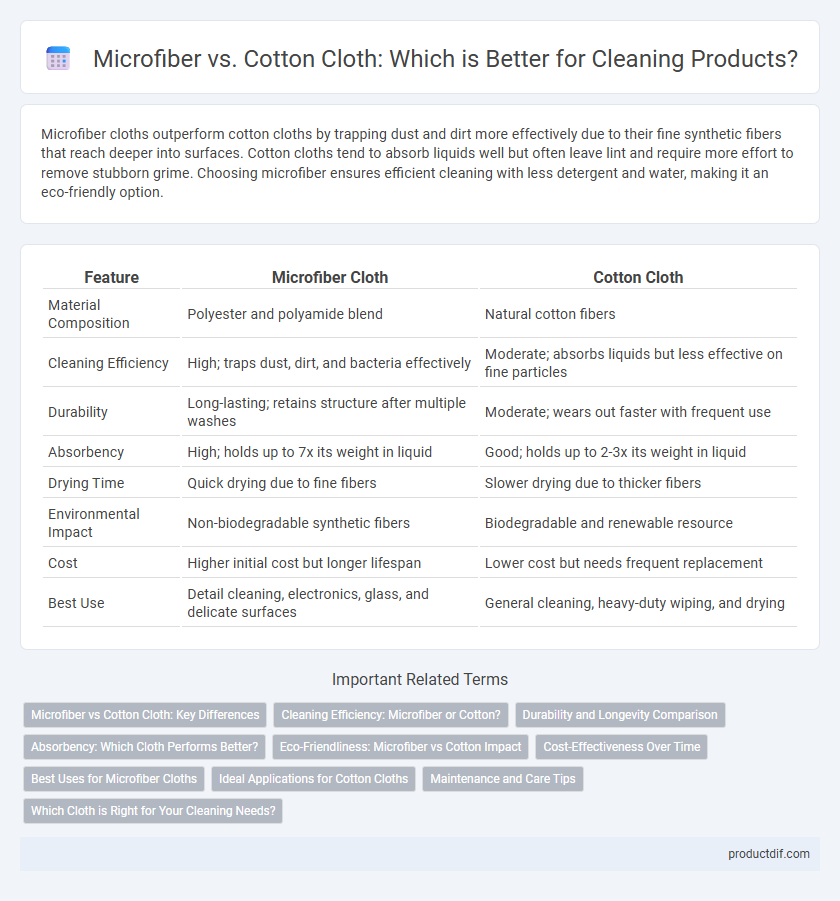Microfiber cloths outperform cotton cloths by trapping dust and dirt more effectively due to their fine synthetic fibers that reach deeper into surfaces. Cotton cloths tend to absorb liquids well but often leave lint and require more effort to remove stubborn grime. Choosing microfiber ensures efficient cleaning with less detergent and water, making it an eco-friendly option.
Table of Comparison
| Feature | Microfiber Cloth | Cotton Cloth |
|---|---|---|
| Material Composition | Polyester and polyamide blend | Natural cotton fibers |
| Cleaning Efficiency | High; traps dust, dirt, and bacteria effectively | Moderate; absorbs liquids but less effective on fine particles |
| Durability | Long-lasting; retains structure after multiple washes | Moderate; wears out faster with frequent use |
| Absorbency | High; holds up to 7x its weight in liquid | Good; holds up to 2-3x its weight in liquid |
| Drying Time | Quick drying due to fine fibers | Slower drying due to thicker fibers |
| Environmental Impact | Non-biodegradable synthetic fibers | Biodegradable and renewable resource |
| Cost | Higher initial cost but longer lifespan | Lower cost but needs frequent replacement |
| Best Use | Detail cleaning, electronics, glass, and delicate surfaces | General cleaning, heavy-duty wiping, and drying |
Microfiber vs Cotton Cloth: Key Differences
Microfiber cloths feature ultrafine synthetic fibers that offer superior absorption and trapping of dirt compared to traditional cotton cloths. Cotton cloths are natural, breathable, and softer but lack the efficacy in removing grease and bacteria without added cleaning agents. Microfiber's dense weave creates a more effective barrier against contaminants, making it ideal for hygienic cleaning applications.
Cleaning Efficiency: Microfiber or Cotton?
Microfiber cloths outperform cotton in cleaning efficiency by trapping dirt, dust, and microbes through their dense synthetic fibers, which are up to 100 times finer than human hair. The electrostatic properties of microfiber enhance particle capture without the need for harsh chemicals, making it highly effective for both wet and dry cleaning tasks. Cotton cloths, while absorbent, often leave behind lint and require more effort to remove stubborn grime, resulting in lower overall cleaning performance.
Durability and Longevity Comparison
Microfiber cloths exhibit superior durability and longevity compared to cotton cloths due to their synthetic fibers that resist wear and maintain effectiveness after numerous washes. Cotton cloths tend to degrade faster, losing softness and structural integrity over time, especially when exposed to frequent laundering and harsh cleaning chemicals. Choosing microfiber ensures prolonged use, reducing the need for frequent replacements and enhancing cleaning efficiency over the product's lifespan.
Absorbency: Which Cloth Performs Better?
Microfiber cloths exhibit superior absorbency compared to cotton, capable of holding up to seven times their weight in liquid due to their fine synthetic fibers. Cotton cloths absorb moisture through their natural cellulose fibers but tend to retain less liquid and dry more slowly than microfiber. The enhanced absorbency and quick-drying properties of microfiber make it the preferred choice for efficient cleaning and moisture control.
Eco-Friendliness: Microfiber vs Cotton Impact
Microfiber cloths offer superior eco-friendliness by requiring less water and detergent for cleaning, reducing overall resource consumption. Cotton cloth production typically involves higher water usage and pesticide application, contributing to greater environmental impact. Choosing reusable microfiber products can significantly lower waste and energy consumption compared to conventional cotton alternatives.
Cost-Effectiveness Over Time
Microfiber cloths typically offer greater cost-effectiveness over time due to their durability and superior cleaning performance, reducing the need for frequent replacements and additional cleaning agents. Cotton cloths, while initially cheaper, tend to wear out faster and absorb more moisture, leading to higher long-term costs and less efficient cleaning. Investing in microfiber material can result in lower overall expenses and improved cleaning efficiency for both residential and commercial use.
Best Uses for Microfiber Cloths
Microfiber cloths excel at trapping dust, dirt, and allergens due to their densely woven synthetic fibers, making them ideal for cleaning electronics, glass surfaces, and delicate items without scratching. Their high absorbency and ability to hold multiple times their weight in water ensure efficient drying and streak-free finishes on mirrors and countertops. Microfiber's durability and resistance to bacteria buildup also make it a superior choice for sanitizing kitchens and bathrooms compared to cotton cloths.
Ideal Applications for Cotton Cloths
Cotton cloths excel in absorbing liquids, making them ideal for tasks such as drying dishes, wiping spills, and general household cleaning. Their softness and durability suit delicate surfaces like glass and wood without causing scratches. In comparison to microfiber, cotton is preferable for tasks requiring natural fibers to reduce static and for environments sensitive to synthetic materials.
Maintenance and Care Tips
Microfiber cloths require gentle washing without fabric softeners or bleach to maintain their electrostatic properties and prevent fiber damage, ensuring optimal dust and dirt trapping. Cotton cloths can endure higher temperatures and standard detergents, but frequent washing may cause shrinkage and loss of absorbency over time. Proper drying methods, such as air drying or low heat settings, prolong the lifespan of both microfiber and cotton cleaning cloths by preserving fiber integrity.
Which Cloth is Right for Your Cleaning Needs?
Microfiber cloths excel in trapping dust and absorbing liquids due to their fine synthetic fibers, making them ideal for streak-free cleaning on glass and electronics. Cotton cloths offer natural softness and durability, suitable for general-purpose cleaning and polishing without scratching surfaces. Choosing between microfiber and cotton depends on the specific cleaning task, as microfiber is better for detailed, residue-free results while cotton works well for heavy-duty wiping and gentle polishing.
Microfiber vs Cotton cloth Infographic

 productdif.com
productdif.com